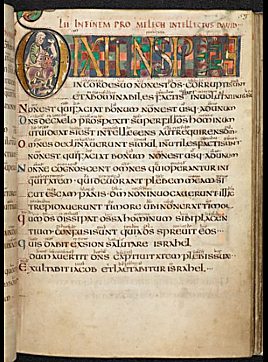 |
| Paleography
Exercises |
|
Vespasian
Psalter, 8th century (British Library, Cotton Vespasian A1 f.53r). All photographs
by permission of the British Library.
Reproduction of these images is permitted under Creative Commons licence. |
 |
This
prestigious psalter was produced in England, possibly in the late 8th century. The precise dating of early manuscripts is always open to a number of possibilities. The text is essentially St Jerome's earliest translation of the Psalms, known as the Roman version, but with some variants based on his later Gallican and Hebrew translations and the earlier Old Latin versions. Medieval texts tended to be like that. The Latin text is written in an elegant and formal uncial script, which at one stage in the history of the great British cultural cringe was considered to be too good to have been done by English scribes, but it seems that scholars have decided that English scribes were capable of producing fine examples of this script after all. At some stage, possibly in the early 9th century, an interlinear gloss was added in the Mercian dialect of Old English in a pointed insular minuscule. This served as a rough kind of translation of the text. |
|
The volume is famed for its headings and illustrations, including miniatures and the very early use of historiated initials. The volume also contains, unusually, whole pages written out in rustic capitals. There is a script sample and paleography exercise for one of these pages among these exercises. The text of the page displayed here is Psalm 52 in the Vulgate Bible, equivalent to Psalm 53 in a modern Bible. Being a short and snappy psalm, it fits neatly on a single page. |
|
This paleography exercise will concentrate on the Latin uncial text, as the Old English text is very tiny and scattered about the page. There is a script example for the Old English text which gives you a look at the letter forms of the gloss. |
|
|
overview | heading | text | alphabet
| abbreviations | exercises
| transcript
| translation | |
|
Click
on each of the above to walk your way through the text. The transcript
will appear in a separate window so that you can use it for reference
at any time. These exercises are designed to guide you through the text,
not test you, so you can cheat as much as you like. |
 Script sample page for uncial script in this example Script sample page for uncial script in this example |
 Script sample page for insular minuscule script in this example Script sample page for insular minuscule script in this example |
 Index
of Exercises Index
of Exercises |
 Index
of Scripts Index
of Scripts |
|
 |
|